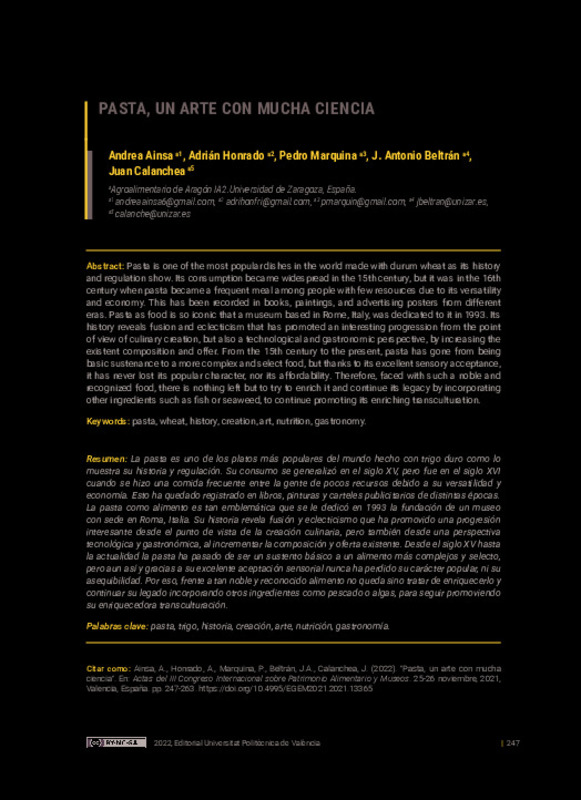JavaScript is disabled for your browser. Some features of this site may not work without it.
Buscar en RiuNet
Listar
Mi cuenta
Estadísticas
Ayuda RiuNet
Admin. UPV
Pasta, un arte con mucha ciencia
Mostrar el registro sencillo del ítem
Ficheros en el ítem
| dc.contributor.author | Ainsa, Andrea
|
es_ES |
| dc.contributor.author | Honrado, Adrián
|
es_ES |
| dc.contributor.author | Marquina, Pedro
|
es_ES |
| dc.contributor.author | Beltrán, José Antonio
|
es_ES |
| dc.contributor.author | Calanche, Juan
|
es_ES |
| dc.date.accessioned | 2022-07-25T08:41:44Z | |
| dc.date.available | 2022-07-25T08:41:44Z | |
| dc.date.issued | 2022-03-04 | |
| dc.identifier.isbn | 9788490489963 | |
| dc.identifier.uri | http://hdl.handle.net/10251/184704 | |
| dc.description.abstract | [EN] Pasta is one of the most popular dishes in the world made with durum wheat as its history and regulation show. Its consumption became widespread in the 15th century, but it was in the 16th century when pasta became a frequent meal among people with few resources due to its versatility and economy. This has been recorded in books, paintings, and advertising posters from different eras. Pasta as food is so iconic that a museum based in Rome, Italy, was dedicated to it in 1993. Its history reveals fusion and eclecticism that has promoted an interesting progression from the point of view of culinary creation, but also a technological and gastronomic perspective, by increasing the existent composition and offer. From the 15th century to the present, pasta has gone from being basic sustenance to a more complex and select food, but thanks to its excellent sensory acceptance, it has never lost its popular character, nor its affordability. Therefore, faced with such a noble and recognized food, there is nothing left but to try to enrich it and continue its legacy by incorporating other ingredients such as fish or seaweed, to continue promoting its enriching transculturation. | es_ES |
| dc.description.abstract | [ES] La pasta es uno de los platos más populares del mundo hecho con trigo duro como lo muestra su historia y regulación. Su consumo se generalizó en el siglo XV, pero fue en el siglo XVI cuando se hizo una comida frecuente entre la gente de pocos recursos debido a su versatilidad y economía. Esto ha quedado registrado en libros, pinturas y carteles publicitarios de distintas épocas. La pasta como alimento es tan emblemática que se le dedicó en 1993 la fundación de un museo con sede en Roma, Italia. Su historia revela fusión y eclecticismo que ha promovido una progresión interesante desde el punto de vista de la creación culinaria, pero tambien desde una perspectiva tecnológica y gastronómica, al incrementar la composición y oferta existente. Desde el siglo XV hasta la actualidad la pasta ha pasado de ser un sustento básico a un alimento más complejos y selecto, pero aun así y gracias a su excelente aceptación sensorial nunca ha perdido su carácter popular, ni su asequibilidad. Por eso, frente a tan noble y reconocido alimento no queda sino tratar de enriquecerlo y continuar su legado incorporando otros ingredientes como pescado o algas, para seguir promoviendo su enriquecedora transculturación. | es_ES |
| dc.format.extent | 15 | es_ES |
| dc.language | Español | es_ES |
| dc.publisher | Editorial Universitat Politècnica de València | es_ES |
| dc.relation.ispartof | Actas del III Congreso Internacional sobre Patrimonio Alimentario y Museos | |
| dc.rights | Reconocimiento - No comercial - Compartir igual (by-nc-sa) | es_ES |
| dc.subject | Alimentación | es_ES |
| dc.subject | Cultura | es_ES |
| dc.subject | Museo | es_ES |
| dc.subject | Pasta alimenticia | es_ES |
| dc.subject | Gastronomía | es_ES |
| dc.subject | Trigo | es_ES |
| dc.subject | Wheat | es_ES |
| dc.subject | Historia | es_ES |
| dc.subject | History | es_ES |
| dc.subject | Creación | es_ES |
| dc.subject | Creation | es_ES |
| dc.subject | Arte | es_ES |
| dc.subject | Art | es_ES |
| dc.subject | Nutrición | es_ES |
| dc.subject | Gastronomy | es_ES |
| dc.title | Pasta, un arte con mucha ciencia | es_ES |
| dc.type | Capítulo de libro | es_ES |
| dc.type | Comunicación en congreso | es_ES |
| dc.identifier.doi | 10.4995/EGEM2021.2021.13365 | |
| dc.rights.accessRights | Abierto | es_ES |
| dc.description.bibliographicCitation | Ainsa, A.; Honrado, A.; Marquina, P.; Beltrán, JA.; Calanche, J. (2022). Pasta, un arte con mucha ciencia. En Actas del III Congreso Internacional sobre Patrimonio Alimentario y Museos. Editorial Universitat Politècnica de València. 247-261. https://doi.org/10.4995/EGEM2021.2021.13365 | es_ES |
| dc.description.accrualMethod | OCS | es_ES |
| dc.relation.conferencename | 3er Congreso Internacional sobre Patrimonio Alimentario y Museos | es_ES |
| dc.relation.conferencedate | Noviembre 25-26, 2021 | es_ES |
| dc.relation.conferenceplace | Valencia, España | es_ES |
| dc.relation.publisherversion | http://ocs.editorial.upv.es/index.php/EGEM/EGEM2021/paper/view/13365 | es_ES |
| dc.description.upvformatpinicio | 247 | es_ES |
| dc.description.upvformatpfin | 261 | es_ES |
| dc.type.version | info:eu-repo/semantics/publishedVersion | es_ES |
| dc.relation.pasarela | OCS\13365 | es_ES |








